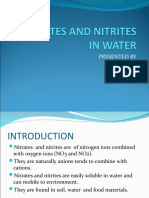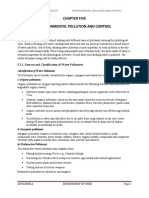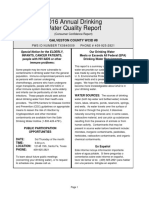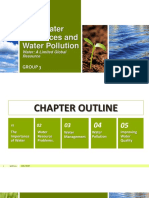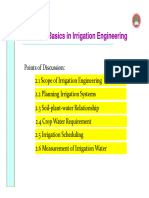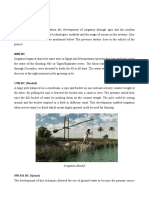Nitrate
Nitrate
Uploaded by
Antônio PereiraCopyright:
Available Formats
Nitrate
Nitrate
Uploaded by
Antônio PereiraOriginal Description:
Copyright
Available Formats
Share this document
Did you find this document useful?
Is this content inappropriate?
Copyright:
Available Formats
Nitrate
Nitrate
Uploaded by
Antônio PereiraCopyright:
Available Formats
Nitrate in Groundwater
Ga llat in Lo cal W ate r Qual it y Dist rict
What is nitrate?
Nitrate is made up of nitrogen and oxygen (chemical formula NO3ˉ ). A naturally occurring January 2015
compound, it is an essential nutrient for plants. It is formed when nitrogen from ammonia or
other sources combines with oxygen in water. Nitrate is tasteless, odorless and colorless.
Where does nitrate come from?
Nitrogen is a natural part of the environment. The atmosphere is 78% nitrogen (N2) by
volume. During the process of soil formation, nitrogen accumulates in the soil. Nitrogen
stored in organic matter in the soil is converted into nitrate by bacteria.
Nitrate is found in plants, animal manure, human waste (septic systems and sewage sludge),
manufactured fertilizers made of nitrogen and ammonium, and airborne nitrogen compounds
given off by industry and automobiles deposited on the land in precipitation and dry particles.
Small amounts of nitrate are naturally found in groundwater. In nature, water usually contains
less than 1 milligram (mg) of nitrate-nitrogen per liter and is not considered a major source of
nitrate exposure. Researchers agree that naturally-occurring nitrate-nitrogen concentrations in
groundwater seldom exceed 3-4 milligrams per liter (Lamond, Powell & Devlin; 1999).
How does nitrate get into groundwater?
Common
Nitrate dissolves easily in water. When rain, snowmelt or irrigation water travels across the sources of
land, it carries nitrate (and other contaminants) with it. As this water percolates (moves down- nitrate in
ward) through the soil, it will eventually migrate to an underlying aquifer. groundwater:
In addition to being soluble in water, nitrate is very stable, meaning it rarely combines with Septic systems
other compounds. It also does not bind to soil particles like many water contaminants do.
This means nitrate will move around with groundwater and you could find a nitrate problem Fertilizers
miles away from a potential source or years after a farm or other source for nitrate is gone.
Manure
Most nitrate that enters the groundwater comes from human (anthropogenic) sources. The im-
proper siting, operation or maintenance of septic systems, improper manure management Decaying plant
practices in feedlots and barnyards, and over-application of fertilizers on agricultural crops and material
urban/suburban lawns contribute significantly to the loading of nitrate to groundwater. Airborne nitrogen
compounds from
industry and
Why is nitrate a concern in groundwater? automobiles
High levels of nitrate in drinking water are associated with adverse health effects. Of particular
concern are persons using private/domestic (non-public) wells that receive little or no water
quality monitoring. Without monitoring, users may not realize they are being exposed to high
nitrate levels.
High nitrate levels found in drinking water may also indicate the presence of other types of
contaminants such as coliform bacteria, viruses, and other human pathogens as well as
pesticides.
Page 2 Nitrate in Groundwater
What are the health effects from high
nitrate?
Health effects and symptoms in infants:
Infants under six months of age are at risk of nitrate poisoning, called methemoglobine-
Nitrate levels in the mia. Toxic effects occur when bacteria in the infant stomach convert nitrate to more toxic
Gallatin Valley nitrite. When nitrite enters the bloodstream, it interferes with the body’s ability to carry
oxygen to the body tissues. Symptoms include shortness of breath and blueness of the skin
Overall, nitrate levels in the around the eyes and mouth (blue-baby syndrome). Infants with these symptoms need
valley are below the federal immediate medical care since the condition can lead to coma and eventually death. As an
MCL of 10 mg/L. There are
additional precaution, nursing mothers may want to avoid drinking water high in nitrate.
isolated areas with levels
ranging from 5-10 mg/L and
a few areas where it is above Health effects and symptoms in children and adults:
the MCL standard. Children over six months old and adults are not susceptible to methemoglobinemia
because they have enough stomach acid to inhibit the growth of the bacteria that cause it.
Of the 282 wells sampled in In healthy adults and children, ingested nitrate is excreted rapidly in the urine.
the Gallatin Valley in 2010
and 2011 through the Well Some scientific studies suggest a linkage between high nitrate levels in drinking water
Educated Program, only 4 with birth defects and certain types of cancer. Further long-term scientific studies are
exceeded the drinking water needed to determine direct linkages. According to the EPA, long-term exposure to water
standard for nitrate. Nitrate with high nitrate levels can cause diuresis (excessive discharge of urine), increased starchy
values ranged from 0-12.2 deposits, and hemorrhaging of the spleen. People with heart or lung disease, reduced
mg/L with an average of gastric acidity, certain inherited enzyme defects (ie, methemoglobin reductase) cancer,
2 mg/L. (MSU-Extension and women who are pregnant may be more susceptible to the toxic effects of nitrate than
Water Quality Well Educated
others.
Program).
Are there standards or regulations for
nitrate in groundwater?
A maximum contaminant level (MCL) of 10 mg/L (milligrams per liter) has been
established by the U.S. Environmental Protection Agency for nitrate in drinking water.
This is a health-based standard set because of the health risk to infants. The standard
Did you know… applies to all public water systems (municipalities and community water systems) and is
used as an advisory for private wells. Public water supply systems are required to test for
Groundwater wells supply various contaminants, including nitrate, on a regular basis. There are no testing
most residents of Gallatin regulations for private wells.
County with their drinking
water. The exception is the
City of Bozeman, which How and where do I test for nitrate?
relies on surface water. The only way to know if drinking water is contaminated with nitrate is to have it tested.
Although, a small percentage For homes on a private well, it is the homeowner’s responsibility to have their water tested.
of drinking water supplied
The Gallatin Local Water Quality District (GLWQD) recommends that homeowners test
by the City of Bozeman does
come from a groundwater
their wells for nitrate (and bacteria) on an annual basis at a minimum. If there are infants
spring. less than six months of age and/or pregnant women in the household, the homeowner may
want to consider testing the water more frequently.
There are numerous certified laboratories in Montana that can test your drinking water for
nitrate as well as other water quality parameters. For a complete listing of laboratories, to
obtain the required sampling bottles, and sample collection instructions, contact the
GLWQD at (406) 582-3168. You can also visit our website at www.glwqd.org to
download our fact sheets on certified laboratories and how to collect a water sample.
Page 3
My water is high in nitrate…now what?
If the nitrate concentration exceeds the MCL of 10 mg/L, do not give the water to any
infant under six months of age, either directly or in formula. Give them water from a
source that has been tested to meet the nitrate standard. Commercially bottled water is Recommendations
required to meet the nitrate standard and is fine for infants. An alternative supply is also a if nitrate level
possible solution, such as relocating or deepening a well.
exceeds 10 mg/L:
Can I boil my water to reduce or eliminate nitrate levels to a safe amount? NO! Boiling
will actually increase the concentration of nitrates due to evaporation of the water. Do not give the water to
infants less than 6
Water Treatment Systems months of age or use it
Reverse osmosis, ion exchange and distillation are types of water treatment systems that to prepare baby
can remove nitrate. Carbon adsorption filters, mechanical filters of various types, and formula.
standard water softeners do not remove nitrate.
To find a water treatment company locally, look up “Water Purification and/or Treatment” Avoid drinking the water
online or in the phone book. Contact the company to see which treatment systems listed during pregnancy.
above they sell and which will work best for you. Remember, these home water treatment
Do not boil the water for
units are not recommended for treating high nitrate levels in water that will be given to an
infant since there is no fool-proof way of knowing when the treatment system may fail. drinking; this will
Therefore, installing a home water treatment system does not mean regular water testing actually increase the
can be discontinued. Each type of treatment system has advantages and disadvantages nitrate level by
and no single system will correct all water quality problems. concentrating it.
Reverse Osmosis . Pressure is used to force water through a semi-permeable membrane, Seek medical help
filtering out most impurities. According to manufacturers' literature, 85-95% of nitrate can
immediately if an infant
be removed. Actual removal rates may vary, depending on the initial quality of the water,
the system pressure, and water temperature. shows symptoms of
methemoglobinemia.
Ion Exchange. Special anion exchange resins are used that exchange chloride ions for
nitrate and sulfate ions in the water as it passes through the resin. Since most anion Identify the nitrate
exchange resins have a higher selectivity for sulfate than nitrate, the level of sulfate in the source and then
water is an important factor in the efficiency of an ion exchange system for removing remove/reduce it.
nitrates. Disposable mixed-bed deionizers is an ion-exchange process where virtually all
the dissolved ions in the water can be removed. This type of system uses both anion and Individuals with chronic
cation exchange resins. health problems which
Distillation. The process involves boiling the water, collecting and condensing the steam increase sensitivity to
via a metal coil and removes nearly 100% of the nitrate. nitrate should limit or
stop daily intake of the
water.
Limit your daily intake if
you are concerned about
the scientific uncertainty
for long-term exposure.
Reduce the risk of nitrate contamination to your well
The risk of groundwater contamination from nitrate depends upon a couple of factors:
nitrogen input to the land surface and the aquifer’s vulnerability to nitrate leaching and Is my well at risk?
accumulation (usually based on soil properties; i.e., well-drained soils or poorly drained Shallow well depth (less
soils). than 100 feet deep)
Conduct an inventory of your property: Identify and remove sources of nitrate near
Areas with highly porous,
your well. Fertilizers, animal waste and sewage systems should be located and managed
sandy soils.
so they do not contaminate the well. If a nitrate source is too close to the well and cannot
be moved, then you may need to install a household water treatment system designed to Improperly constructed
remove nitrate or hire a licensed well contractor to permanently seal and abandon your or maintained well.
existing well and have a new well drilled in a different location and/or to a deeper depth.
Improperly maintained
Proper well location: Wells should be located upgradient (uphill) and at least 100 feet septic system.
away from septic systems (drainfield and tank).
Immediately down-
Proper well construction: Make sure your well casing extends above the ground gradient of animal feed-
surface (18 inches is recommended). Construct an earth berm around the well to divert lot, barnyard, area of
surface water runoff away from the wellhead. For more well tips see the GLWQD fact high density septic
sheet, Top 10 Well Maintenance Tips. systems, septic “sludge”
Maintain your septic system: A failing or improperly maintained septic system is application site.
unable to properly treat human waste which can lead to higher concentrations of nitrate Improper/overuse of
and other water contaminants entering an aquifer. Good septic system care includes: fertilizers.
Having your tank pumped on a regular basis by a licensed contractor. Don’t drive
vehicles over your drainfield or tank. Avoid planting trees and shrubs near the drain Groundwater moves
pipes or drainfield as the roots can clog the lines. Do not dispose of chemicals or non- slowly, so it can take
biodegradable materials in your toilet or drain. years for nitrate to reach
a well. A well that tests
Reduce your use of garden and lawn fertilizers: Use only when necessary and
safe for nitrate today
according to the manufacturer’s application instructions. More is not better!
could show contamina-
tion in the future.
Additional Resources:
Gallatin City-County Environmental Health Department, 215 W. Mendenhall, Rm 108, Bozeman. (406) 582-3120. www.gallatin.mt.gov
EPA Safewater Page: www.epa.gov/safewater/contaminants/dw_contamfs/nitrates.html
World Health Organization: http://www.who.int/water_sanitation_health/dwq/chemicals/nitratenitrite_background.pdf
NSF International, Home Water Treatment: http://www.nsf.org/consumer/drinking_water/dw_treatment.asp?program=WaterTre
Bibliography:
Basics of deionization. January 2004. Water Tech.ONLINE. www.watertechonline.com
Lamond, Ray E., G. Morgan Powell, and Dan Devlin, Nitrate and Groundwater, Kansas State University, April 1999.
National Research Council, Nitrate and Nitrite in Drinking Water, National Academy Press, Washington DC, 1995. http://books.nap.edu/catalog/9038.html#toc
Nitrate and ground water. Southern Nevada Health District. 2005. www.cchd.org/disease_factsheets/nitrate.htm
Nitrate in drinking water and human health. Weyer, Peter. Center for Health Effects of Environmental Contamination, The University of Iowa, August 2001.
http://www.agsafetyandhealthnet.org/Nitrate.PDF
Nitrate in groundwater. Santa Clara Valley Water District. 2002. www.valleywater.org.
Nitrates and Nitrites in Drinking Water. Wilkes University Center for Environmental Quality, Environmental Engineering and Engineering Department.
www.water-research.net/nitrate.htm
Nitrates/What You Need to Know. National Ground Water Association, Inc. 2006. www.wellowner.org.
Walton, Graham, Survey of Literature Relating to Infant Methemoglobinemia Due to Nitrate-Contaminated Water, American Journal of Public Health, 41:986-
996, August 1951.
United States Environmental Protection Agency, Office of Water, http://www.epa.gov/OW/
Gallatin Local Water Quality District
Working to protect the groundwater and surface 215 W. Mendenhall, Suite 300
water resources within the District. Bozeman, MT 59715
(406) 582-3168
www.glwqd.org
You might also like
- What Is NitrateDocument6 pagesWhat Is NitratePrince VinceNo ratings yet
- Nitrate and Nitrite Fact Sheet 2022Document7 pagesNitrate and Nitrite Fact Sheet 2022Ahmed AliNo ratings yet
- Nitrates ClipDocument1 pageNitrates Clipeduard009No ratings yet
- Sample WorkDocument4 pagesSample WorkIsha GosainNo ratings yet
- A Study of Nitrate Contamination in Ground Water of Delhi IndiaDocument13 pagesA Study of Nitrate Contamination in Ground Water of Delhi IndiaAnupama MahajanNo ratings yet
- Testing Water For NitrateDocument3 pagesTesting Water For NitrateMohamad Shafiq Saleh UddinNo ratings yet
- Nitrate in Drinking Water: Questions & AnswersDocument2 pagesNitrate in Drinking Water: Questions & Answersmanju.aalawakaNo ratings yet
- Presentation 1Document10 pagesPresentation 1Jipin NathNo ratings yet
- Nitrate Nitrite EngDocument8 pagesNitrate Nitrite EngOproiu VladNo ratings yet
- STUDENT ACTIVITY: Testing Water For NitrateDocument3 pagesSTUDENT ACTIVITY: Testing Water For NitrateLoisNo ratings yet
- Nitrate and NitriteDocument8 pagesNitrate and Nitritesyafiqabang75% (4)
- Ijrras 7 2 15Document10 pagesIjrras 7 2 15Ruchita PoilkarNo ratings yet
- Clean Drinking Water From Air Conditioner: ResearchDocument9 pagesClean Drinking Water From Air Conditioner: ResearchSajib Chandra RoyNo ratings yet
- CCR Report Dispatch 2017Document5 pagesCCR Report Dispatch 2017james keller100% (1)
- Thesis Water Treatment PDFDocument34 pagesThesis Water Treatment PDFAzlyn SyafikahNo ratings yet
- Ground Water Nitrate Removal by Using Chitosan' As An AdsorbentDocument4 pagesGround Water Nitrate Removal by Using Chitosan' As An AdsorbentIJMERNo ratings yet
- Environmental Ecology - 5Document24 pagesEnvironmental Ecology - 5Seble GetachewNo ratings yet
- Electrodialisis PDFDocument5 pagesElectrodialisis PDFJulio TovarNo ratings yet
- Who StandarsDocument16 pagesWho StandarsajaipurushothamanNo ratings yet
- Water Purification Focus On DistillationDocument20 pagesWater Purification Focus On DistillationKiran KumarNo ratings yet
- Low-Cost Drinking Water Purification - Dr. AzeemDocument76 pagesLow-Cost Drinking Water Purification - Dr. Azeem7hg5vr9fzkNo ratings yet
- Jelana Fredericks Caribbean Studies IADocument27 pagesJelana Fredericks Caribbean Studies IAJelana FredericksNo ratings yet
- Water Purification Focus On Distillation MAY18Document20 pagesWater Purification Focus On Distillation MAY18Mariangélica DominiNo ratings yet
- Town of La Plata 2015 Drinking Water Quality ReportDocument4 pagesTown of La Plata 2015 Drinking Water Quality ReportWJLA-TVNo ratings yet
- Heramba Chandra College ProjectDocument11 pagesHeramba Chandra College Projectnkkabi9No ratings yet
- 9) Guimei Yu Et Al, 2020Document6 pages9) Guimei Yu Et Al, 2020yesuf4assefaNo ratings yet
- A Guide To Water FiltrationDocument4 pagesA Guide To Water FiltrationMihai PopaNo ratings yet
- TX0230001 - 2018 - 2019 05 07 - 08 50 38Document5 pagesTX0230001 - 2018 - 2019 05 07 - 08 50 38james kellerNo ratings yet
- Nitrate and Nitrite Removal From Municipal Drinking Water Supplies With Electrodialysis ReversalDocument5 pagesNitrate and Nitrite Removal From Municipal Drinking Water Supplies With Electrodialysis ReversalDesiana NurulhNo ratings yet
- Irjaes V1n3p90y16 PDFDocument3 pagesIrjaes V1n3p90y16 PDFIsmaila KhairanNo ratings yet
- Water Purification Technology in Zambia by Beatrice HallmarkDocument35 pagesWater Purification Technology in Zambia by Beatrice HallmarkckmuneesNo ratings yet
- Nitrates in Drinking Water and Methemoglobin Levels in Pregnancy A Longitudinal StudyDocument12 pagesNitrates in Drinking Water and Methemoglobin Levels in Pregnancy A Longitudinal StudykNo ratings yet
- Public Notice For Nitrate Exceedance Jul 29 16Document1 pagePublic Notice For Nitrate Exceedance Jul 29 16api-244876079No ratings yet
- Microsoft Word - Nit9Document10 pagesMicrosoft Word - Nit9api-409012742No ratings yet
- Drinking Water and Health: What You Need To Know!Document11 pagesDrinking Water and Health: What You Need To Know!Hafiz Hibba Tur RahmanNo ratings yet
- Tigard OR - Annual Water 2013Document8 pagesTigard OR - Annual Water 2013scribe500No ratings yet
- Inorganic Water Quality Parameters NitratespdfDocument6 pagesInorganic Water Quality Parameters NitratespdfJEZREEL JOHN GENESENo ratings yet
- VSEP Treatment of RO Reject From Brackish Well WaterDocument19 pagesVSEP Treatment of RO Reject From Brackish Well WaterPrashantAroraNo ratings yet
- ProjectDocument30 pagesProjectSudhir TiwariNo ratings yet
- What Are Micropollutants in Water - Netsol WaterDocument1 pageWhat Are Micropollutants in Water - Netsol Water98zjwkvysjNo ratings yet
- Nitrate in Potable Water Supplies Alternative Management StrategiesDocument85 pagesNitrate in Potable Water Supplies Alternative Management StrategiesceciliaNo ratings yet
- Drinking Water QualityDocument2 pagesDrinking Water QualityHafifi NazirNo ratings yet
- GC CCR 2023Document5 pagesGC CCR 2023api-325255216No ratings yet
- Determination of Nitrate and Nitrite Levels in Infant Foods Marketed in Southern ItalyDocument7 pagesDetermination of Nitrate and Nitrite Levels in Infant Foods Marketed in Southern Italysamuel tralalaNo ratings yet
- Review On Recent Advances in Synthesis of Black TiO2Document13 pagesReview On Recent Advances in Synthesis of Black TiO2International Journal of Innovative Science and Research TechnologyNo ratings yet
- Name - Rohit Thirupasur Class - Xi Subject - Chemistry Project OnDocument21 pagesName - Rohit Thirupasur Class - Xi Subject - Chemistry Project OnRohit Thirupasur100% (2)
- Impact of Water Quality On Food Processing and Human HealthDocument5 pagesImpact of Water Quality On Food Processing and Human HealthAlokaNo ratings yet
- City of Elkins, W. Va. Consumer Confidence Report - 2021Document5 pagesCity of Elkins, W. Va. Consumer Confidence Report - 2021SuttonStokesNo ratings yet
- Mo2010512 2Document2 pagesMo2010512 2api-278699601No ratings yet
- Environmental Protection Agency Reveals That Only Nine U.S. States Are Reporting Safe Levels of Lead in Their Water SupplyDocument9 pagesEnvironmental Protection Agency Reveals That Only Nine U.S. States Are Reporting Safe Levels of Lead in Their Water SupplyFahad AreebNo ratings yet
- Potassium Nitrate Is An Outstanding Source of Potassium For Its Nutritional Value - SQMCDocument3 pagesPotassium Nitrate Is An Outstanding Source of Potassium For Its Nutritional Value - SQMCMichaelArdnahcRakesNo ratings yet
- Water PurificationDocument17 pagesWater PurificationsimonaNo ratings yet
- 2016 Annual Drinking Water Quality Report: Galveston County Wcid #8Document5 pages2016 Annual Drinking Water Quality Report: Galveston County Wcid #8Dee Ann Pulley HedgpethNo ratings yet
- Water PurificationDocument24 pagesWater Purificationrohithgm3733No ratings yet
- Water Quality Online-Summer Maria ArriagaDocument6 pagesWater Quality Online-Summer Maria ArriagaM ArNo ratings yet
- A Feasibility Report: Choosing The Best Water Filtration SystemDocument11 pagesA Feasibility Report: Choosing The Best Water Filtration Systemapi-312733333No ratings yet
- The Problem and Its BackgroundDocument172 pagesThe Problem and Its BackgroundJefi NavarroNo ratings yet
- National Testing Laboratories, LTDDocument20 pagesNational Testing Laboratories, LTDmrafig100% (1)
- Water Remote Sensing: Advancements in Computer Vision Techniques for Water Remote SensingFrom EverandWater Remote Sensing: Advancements in Computer Vision Techniques for Water Remote SensingNo ratings yet
- Environmental Performance of Graphene-Based 3D MacrostructuresDocument13 pagesEnvironmental Performance of Graphene-Based 3D MacrostructuresAntônio PereiraNo ratings yet
- EEEEDocument3 pagesEEEEAntônio PereiraNo ratings yet
- Livro Fmea PDFDocument3 pagesLivro Fmea PDFAntônio PereiraNo ratings yet
- Certificate of Criminal RecordDocument1 pageCertificate of Criminal RecordAntônio PereiraNo ratings yet
- Assessment of Water Refilling StationsDocument27 pagesAssessment of Water Refilling StationsJudy Ann CasucoNo ratings yet
- Evidencia HidrodinámicaDocument14 pagesEvidencia HidrodinámicaCesar Canul-MacarioNo ratings yet
- 7-2 Infiltration ModelsDocument18 pages7-2 Infiltration ModelsStavan Lakhdharia100% (2)
- PROAIN Presentation February 2016 EnglishDocument235 pagesPROAIN Presentation February 2016 Englishanyerson pizo ossaNo ratings yet
- Lecture # 1 & 2 IntroductionDocument37 pagesLecture # 1 & 2 IntroductionJabran NawazNo ratings yet
- IrrigattionDocument30 pagesIrrigattionAnurag VermaNo ratings yet
- Nullah RejuvinationDocument21 pagesNullah Rejuvinationekam ecoNo ratings yet
- Important Factors For Location of An IntakeDocument7 pagesImportant Factors For Location of An IntakeAbhishek BhattNo ratings yet
- Freshwater Resources and Water PollutionDocument61 pagesFreshwater Resources and Water PollutionAbbey Joy Collano100% (1)
- PDFDocument3 pagesPDFItaliya ChintanNo ratings yet
- Jar Test Lab Report Level 2Document14 pagesJar Test Lab Report Level 2syaaa0% (1)
- Rain Water Harvesting ProjectDocument8 pagesRain Water Harvesting Projectreenabaskey2024No ratings yet
- Bandhara IrrigationDocument13 pagesBandhara IrrigationAto DopingNo ratings yet
- Water SecurityDocument18 pagesWater Securityjosephshaji9820No ratings yet
- STP Technology Options: Moving Bed Bioreactor (MBBR) Membrane Bioreactor (MBR)Document6 pagesSTP Technology Options: Moving Bed Bioreactor (MBBR) Membrane Bioreactor (MBR)amzad aliNo ratings yet
- GWH Excercise 2Document4 pagesGWH Excercise 2MICHAEL TILAHUNNo ratings yet
- Different Types of Irrigation System Advantages and DisadvantagesDocument12 pagesDifferent Types of Irrigation System Advantages and DisadvantagesEngr.Iqbal Baig100% (2)
- Midterm Exam Irrigation and Water ManagementDocument3 pagesMidterm Exam Irrigation and Water ManagementRamos, Keith A.100% (1)
- Textile Wastewater TreatmentDocument21 pagesTextile Wastewater TreatmentRonak JoshiNo ratings yet
- "Effluent Treatment Using Biodegradable Material": Design Engineering - IIBDocument19 pages"Effluent Treatment Using Biodegradable Material": Design Engineering - IIBUnknown SoulNo ratings yet
- CALCULATION FOR UGWT AND OHWT For Services Sem 9Document5 pagesCALCULATION FOR UGWT AND OHWT For Services Sem 9Sushil GuptaNo ratings yet
- Chap 2 Basics in Irrigation EngineeringDocument62 pagesChap 2 Basics in Irrigation Engineeringzekigirma671No ratings yet
- Q4-Pt-Science 4Document7 pagesQ4-Pt-Science 4Judy Mae LacsonNo ratings yet
- Boil Water Advisory Recovery Checklist BusinessesDocument3 pagesBoil Water Advisory Recovery Checklist BusinessesElizabeth WashingtonNo ratings yet
- Detailed Lesson Plan in Science IiiDocument3 pagesDetailed Lesson Plan in Science Iiicharito riveraNo ratings yet
- II 1 IrriDrainage1 17Document18 pagesII 1 IrriDrainage1 17h26fbrsrqwNo ratings yet
- Aspek Geologi Pantai Bodri - KendalDocument10 pagesAspek Geologi Pantai Bodri - KendalMochamad Luthfi HamidNo ratings yet
- Storm Water Design ExampleDocument5 pagesStorm Water Design ExampleAndre RoyNo ratings yet
- Subsoil Drainage ExcelDocument18 pagesSubsoil Drainage ExcelEric ChanNo ratings yet
- Chapter Two: Irrigation ShadufDocument10 pagesChapter Two: Irrigation ShadufvectorNo ratings yet







